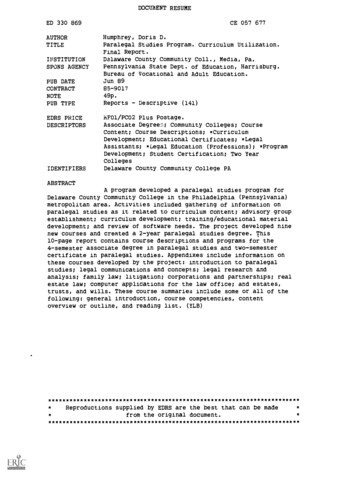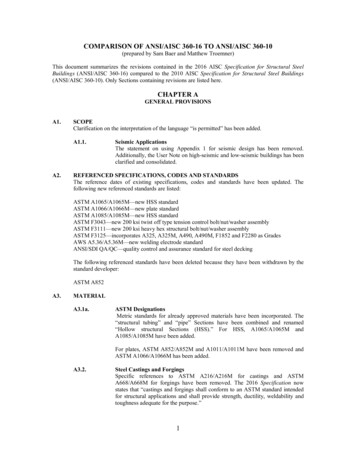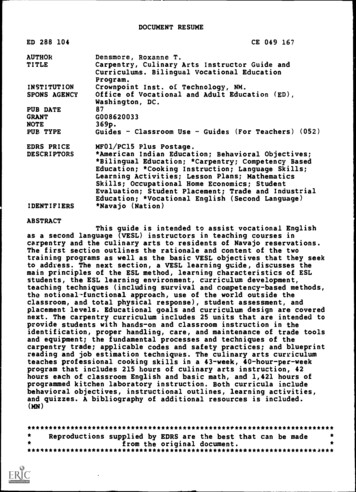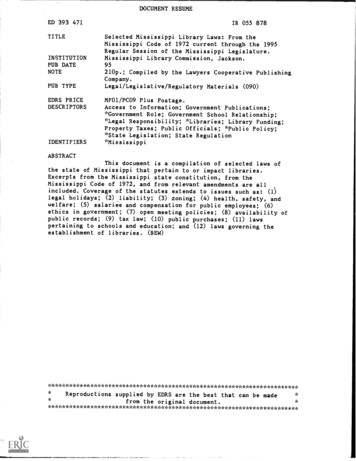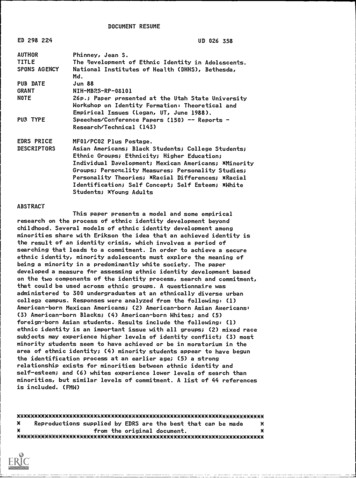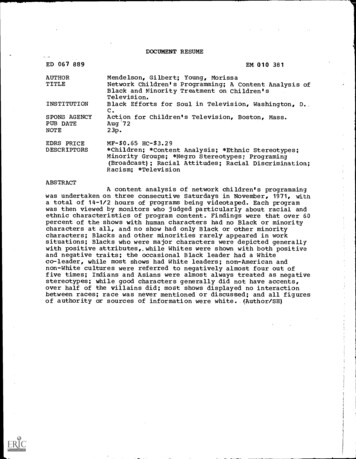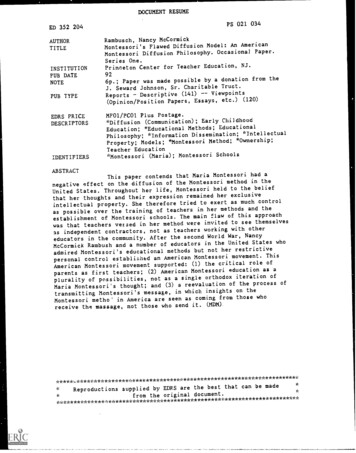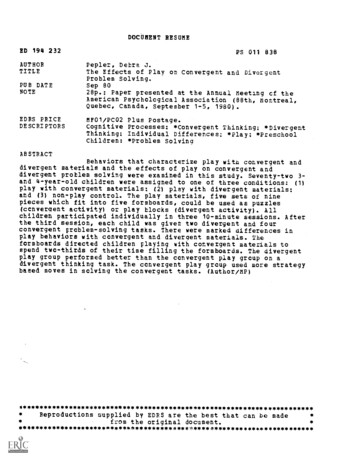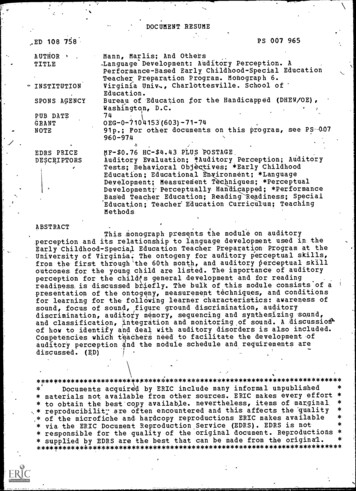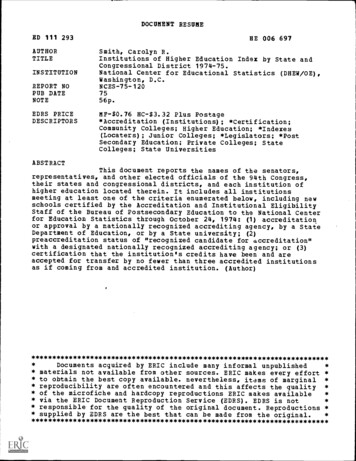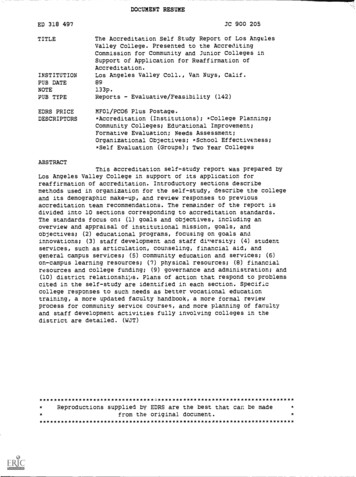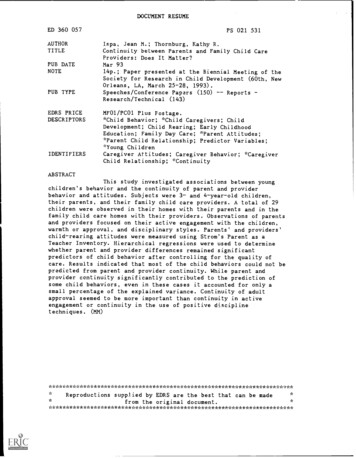
Transcription
DOCUMENT RESUMEED 360 057AUTHORTITLEPUB DATENOTEPUB TYPEEDRS PRICEDESCRIPTORSIDENTIFIERSPS 021 531Ispa, Jean M.; Thornburg, Kathy R.Continuity between Parents and Family Child CareProviders: Does It Matter?Mar 9314p.; Paper presented at the Biennial Meeting of theSociety for Research in Child Development (60th, NewOrleans, LA, March 25-28, 1993).Speeches/Conference Papars (150)ReportsResearch /Technical (143)MFO1 /PCO1 Plus Postage.*Child Behavior; *Child Caregivers; ChildDevelopment; Child Rearing; Early ChildhoodEducation; Family Day Care; *Parent Attitudes;*Parent Child Relationship; Predictor Variables;*Young ChildrenCaregiver Attitudes; Caregiver Behavior; *CaregiverChild Relationship; *ContinuityABSTRACTThis study investigated associations between youngchildren's behavior and the continuity of parent and providerbehavior and attitudes. Subjects were 3- and 4-year-old children,their parents, and their family child care providers. A total of 29children were observed in their homes with their parents and in thefamily child care homes with their providers. Observations of parentsand providers focused on their active engagement with the children,warmth or approval, and disciplinary styles. Parents' and providers'child-rearing attitudes were measured using Strom's Parent as aTeacher Inventory. Hierarchical regressions were used to determinewhether parent and provider differences remained significantpredictors of child behavior after controlling for the quality ofcare. Results indicated that most of the child behaviors could not bepredicted from parent and provider continuity. While parent andprovider continuity significantly contributed to the prediction ofsome child behaviors, even in these cases it accounted for only asmall percentage of the explained variance. Continuity of adultapproval seemed to be more important than continuity in activeengagement or continuity in the use of positive disciplinetechniques. *************************Reproductions supplied by EDRS are the best that can be madefrom the original ******************************
1Continuity Between Parents and Family Child Care Providers:Does It Matter?U.S. DEPARTMENT OF EDUCATIONOffice of Earrcational Research and improvementEDUCATIONAL RESOURCES INFORMATIONCENTER (ERIC)Jean M. Ispa and Kathy R. Thornburgkr is document Ms s been 'produced asfrom the person or OrganitationOriginating it.0 Minor changs have been mad* to improvereOrOduCtiOn QualityDepartment of Human Development and Family StudiesUniversity of Missouri-ColumbiaPantaor view ot opinions stated in this docu-ment do not necessarily reDrsent OftialOERI posifion or policyAbstractThis study investigated associations between parent-providerbehavioral and attitudinal continuity and young children'saxebehavior.Twenty-nine children, their parents and theirfamily child care providers were observed at home and intheir family child care homes.Observations of parents andproviders focused on their warmth and disciplinary styles.Parents' and providers' child-rearing attitudes weremeasured using Strom's Parent as a Teacher Inventory.Hierarchical regressions were used to determine thecontribution of parent-provider continuity beyond that madeby parent and provider frequencies of behavior.Most of thechild behaviors we observed could not be predicted fromparent-provider continuity.Moreover, while parent-providercontinuity did significantly contribute to the prediction ofsome child behaviors, even in these cases it accounted forCr)3only a small percentage of the explained variance.Interestingly, continuity of adult approval, or warmth,4across the two settings seemed to be more important thancontinuity in active engagement or continuity in use ofpositive discipline techniques.Presented at the meetings of the Society for Research inPROCOCE 1116Child Development, New Orleans, March, 1993. PE pm,ssc,,NAA IF kiALFiFE N10 IHE E [it A I itiNntSOUHLP-,INFORMATION CENTER 4ERICI
2Continuity Between Parents and Family Child Care Providers:Does It Matter?Popular and professional wisdom concurs in endorsingcontinuity between parents' and child care providers'Empirical evidencevalues and child-rearing methods.supporting the importance of continuity between settings isThe most closely related work is that oflacking, however.Howes, Rodning, Galluzzo, and Myers (1988) showing thattoddlers' involvement with caregivers and peers is afunction of their attachment to their mothers and theircaregivers, with the highest levels of play occurring amongtoddlers with secure attachments to both.Although research describing child outcomes islimited, there is a considerable body of research describingdifferences between the home and child care settings.Parents and preschool teachers have been found to differ intheir assessments of individual children's behavior (Gray,Clancy, & King, 1981) and in their child-rearingexpectations and values (Alston, 1982; Winetsky, 1978).Researchers have also observed more adult-child interactionand greater intensity of affect at home than in child carecenters (Cochran, 1977; Ispa, Gray, & Thornburg, 1988) or infamily child care homes (Long, Peters, & Garduque, 1985;Siegel-Gorelick, Everson, & Ambron, 1983).While family child care providers and mothers are awareof their behavioral differences, they consider themselves tobe essentially in agreement regarding child-rearing values(Atkinson, 1991; Long & Garduque, 1987; Nelson & Garduque,Also, despite absolute differences between parents1991).and providers, correlational analyses have revealed positiveassociations in their nurturance, involvement in children'stasks, and investment in ensuring compliance (Howes &Olenick, 1986; Howes & Stewart, 1987). Parents appear toplace their children in child care settings of relativelysimilar quality to their own home environments.What we don't know is whether or not, and how,differences between parents' and providers' child-rearingbehaviors and values affect young children. The presentstudy was undertaken to investigate associations between Sand 4-year old children's behavior and the behavioral andattitudinal continuity of their parents and family childcare providers.The Parent as a Teacher Inventory (Strom, 1982) wasused to tap providers' and parents' understanding of childdevelopment and attitudes related to children's needs forObservations of parentsindependence and active learning.and providers focused on their warmth and disciplinarystyle.
3MethodSubjectsThe data for the present analyses come from informationgathered on 29 3- and 4-year-old children, their mothers,fathers, and family child care providers.All children werefrom white, middle-income, two-parent families.Subjects were recruited at meetings of a localassociation of family child care providers and throughletters sent to providers whose names appeared on a Divisionof Family Services list of licensed child care homes. Sothat independence of observations would be maintained,providers were informed that we could observe only one childfrom each child care hrme.Providers were offered 20 forparticipating; parents were offered 25.The children in the sample had been attending theircurrent child care homes for an average of 16.4 months(range 2 - 47 months).Their weekly attendance averaged42 hours (range 25 - 50 hours). Approximately half of theparents (16 of the mothers and 19 of the fathers) hadBachelor's or graduate degrees.The child care providers cared for an average of 8.5children (range 3-15, including part-time attendance).Nint2 had Bachelor's degrees.ProcedureThree one-hour observations were conducted in eachchild's home and two one-hour observations were conducted inOne observer codedeach child's family child care home.Parents and providers werebehavior during each visit.asked to adhere to their usual routine and to disregard theobserver's presence insofar as possible.During each visit to the home, the observer focused oneach individual for two 10-minute periods. Thus, forexample, during the first visit the child was observed for10 minutes, then the mother, then the father, then theDuring each visit to thechild, mother, and father again.child care home, the provider and the child were each thefocus of the observation for three alternating 10-minuteThus each individual was the focus of observationperiods.for a total of 60 minutes (2 visits X 3 10-minute focusperiods in the child care home; 3 visits X 2 10-minute focusperiods in the home). The order in which individuals wereobserved over the visits was counterbalanced.The observers used a time-sampling procedure involving15-second observe, 10-second record cycles. Signalsdemarcating each observation and recording period were
4transmitted to the observer through an earphone connected toa tape recorder.Due to slow subject recruitment, data collection tookplace over the course of three years, necessitating thetraining of new observers each year. A total of ninestudents majoring in child development served as observers.Each year training took place in two child care centerrooms, and continued until reliability on all categories hadreached at least 80%. Below, kappa coefficients averagedacross pairs of observers are shown after the description ofeach variable.MeasuresParent and provider observations.On the codesheetused during the 10-minute observations focusing on theproviders, mothers, or fathers, observers recorded thepresence of behaviors directed toward the focal child andindicative of warmth, encouragement, and frequency and styleof teaching and discipline.Included were the occurrence of(a) active engagement (positive or neutral non-disciplinaryinteraction with children such as playing, helping,conversing, reading aloud, teaching, kappa .90); (b)showing approval (praising or showing affection to children,kappa .81); (c) positive discipline (redirection,reasoning, kappa .87); (d) neutral discipline (simplecommands without reasons, kappa .96); and (e) negativediscipline (the use of physical force or verbal degrading).Negative discipline was not used in the analyses because itwas observed too infrequently to establish reliability.Mothers' and fathers' behavior frequencies wereaveraged to create parent scores. Reports of significantwithin-couple correlations in maternal and paternal childrearing behaviors and attitudes (Belsky & Volling, 1987;Roberts, Block, & Block, 1984) supports the creation of suchscores.The correlations between mother and father scoresin the present sample were positively related (for activeengagement, r .41, p .05, for showing approval, r .33,R .10, and for proportion of positive discipline, r .40,p .05).Child observations. On the codesheet used to recordchildren's behaviors, observers noted the occurrence of(a) unhappiness (frowning, whining, crying, kappa .80),(b) unoccupied behavior (aimless wandering or fidgeting,lack of engagement with materials or persons, kappa .80),(c) on-task behavior (active engagement in a neutral orpositive solitary, parallel, or social activity, kappa .83), (d) positive or neutral social interactions withadults (kappa .86) and with peers (kappa .88) and (e)negative social interactions (behavior that is frustratingto others and/or shows disobedience to parents or providers,rcJ
5kappa .92 for negative behaviors directed towards adultsand .95 for negative behaviors directed towards peers).Attitude questionnaires. Upon completion of the third homeobservation, observers gave parents a mother and a fatherversion of the Parent as a Teacher Inventory (PAAT; Strom,1982) and two stamped, self-addressed envelopes for theirParents were asked to complete the questionnairesreturn.without discussing their responses. Providers were alsogiven the PAAT, slightly reworded so as to be suitable forthem ("my child" was changed to "this child").The PAAT consists of 50 Likert-scale items measuringThornburg, Gray andchild-rearing beliefs and attitudes.Ispa (1989) factor analyzed the instrument separately formothers, fathers, and child care teachers and found foursimilar factors across the three samples. Three of thesefactors (Understanding of Child Development, Support ofChild Inderendence, and Support for Active Learning) wereused in the present study.ResultsObservational DataThree measures of adult behavior were used in theanalyses: (a) parent and provider frequencies of activeengagement, (b) parent and provider frequencies of showingapproval, and (c) the proportion of all disciplinary remarksclassified as positive [positive discipline / (positivediscipline neutral discipline)]. Mothers' and fathers'scores were averaged to create parent scores, and for eachadult behavior variable, the absolute value of thedifference between standardized parent and standardizedprovider scores was calculated. Simultaneous multipleregression analyses were then done to determine whether ornot children's behavior could be predicted by thecombination of the three parent-provider difference scores.Sex of child was not included as an independent variablebecause correlational analyses showed no significantassociations between it and any of the parent-providerdifference scores.Nine of the child behaviors, four at home and five inchild care, could not be predicted from the degree ofparent-provider difference. Specifically, the analysesindicated no relations between the models of parent-providerdifference and children's on-task behavior at home or inchild care, unoccupied behavior at home, positive andnegative interactions with mothers, positive and negativeinteractions with peers in the child care setting, negativeinteractions with providers, or unhappiness in child care.
6The five child behaviors that could be predicted by thelinear combination of the three parent-provider differencevariables included unoccupied behavior in the child carehome, neutral/positiv
used during the 10-minute observations focusing on the providers, mothers, or fathers, observers recorded the presence of behaviors directed toward the focal child and indicative of warmth, encouragement, and frequency and style of teaching and discipline. Included were the occurrence of (a) active engagement (positive or neutral non-disciplinary
